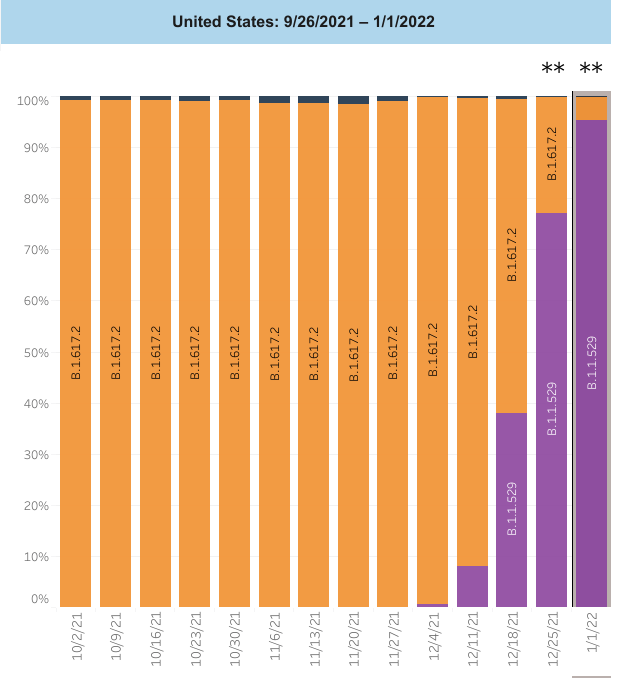Why Children With COVID-19 Swamp Pediatric Hospitals
Omicron is going hard after the pediatric population, many of whom are too young to be vaccinated and whose vital organs, which COVID-19 attacks, are still in development.
The current surge in COVID-19 cases hits children particularly hard, as pediatric hospitals across the United States report a huge influx of patients. That surge is fueled mostly by the Omicron variant, which accounts for 95.4% of new cases in the country, according to the Centers for Disease Control and Prevention (CDC). (See chart below.) There has been a 400% increase in child hospitalizations at Texas Children’s Hospital in Texas, the largest pediatric hospital in the country, since the holidays, CNN reports.
Jim Versalovic, MD, the pathologist-in-chief at Texas Children’s Hospital, tells CNN that “we have staggering numbers here from this Omicron surge already. We shattered prior records that were established during the Delta surge in August.”
There has been much hope (perhaps false hope) pinned to early data about Omicron that suggest that it affects upper airways, and not the lungs, as did Delta and earlier iterations of SARS-CoV-2. A COVID-19 variant that produces mild symptoms and can knock the deadly Delta variant out to the way to become the dominant strain could possibly be a way to end the pandemic. But the surge in pediatric COVID-19 gives pause.
“The pediatric population is more fragile,” reminds Linda Spaulding, RN-BC, CIC, CHEC, CHOP, a member of Infection Control Today®’s (ICT®’s) Editorial Advisory Board. “We’re seeing children as young as 5 days old getting COVID. And we don’t know what the long-term effects on that population will be because their lungs aren’t fully developed, their brains are still growing, their hearts are still fragile.”
As Spaulding noted in an interview with ICT® in February 2021, one of the possible long-term effects of COVID-19 on children is multisystem inflammatory syndrome (MIS-C). As the CDC explains, the condition, which can also affect adults and is called MIS-A in those cases, “is a rare but serious condition associated with COVID-19 in which different body parts become inflamed, including the heart, lungs, kidneys, brain, skin, eyes, or gastrointestinal organs.”
Spaulding says that vaccines aren’t the answer for many pediatric patients because there are no approved vaccines for children 5 years old and younger. “When we are dealing with the pediatric population, we have to deal with getting them through the illness and monitor them for developing MIS-C afterwards,” says Spaulding, of the current COVID-19 surge.
Even children who can get vaccinated aren’t getting vaccinated as much as adult are. According to the CDC, about 61.2% of the total U.S. population have been fully vaccinated. Children are the least fully vaccinated: 53% for those from 12 to 17 years old. Only 14.7% of children from 5 to 11 years old have been vaccinated.
Edith Bracho-Sanchez, MD, a primary care pediatrician and assistant professor of pediatrics at Columbia University Irving Medical Center in New York, agrees with Spaulding that the fact that Omicron affects upper airways and not the lungs isn’t good news for pediatric patients.
“We cannot treat the airways of children like they are the airways of adults,” Bracho-Sanchez tells CNN. “It’s just not the way it works. And for us pediatricians, we know that respiratory viruses can lead to ... croup and bronchiolitis, that inflammation of the upper airways that does get in children in trouble.”
Spaulding adds that “during their early years, a lot of children have asthma and COVID-19 is not a friend to asthma.” Spaulding urges parents to “do their job of protecting those children and not taking them out in the community and around crowds. I see parents all the time at stores with masks on and the baby in the stroller with no mask.”
In the debate about whether schools should be open for in-class instruction, Spaulding believes that now—during a massive COVID-19 surge—is not the time to reopen schools.
“The schools are open and we’re seeing a large increase of children coming home from school positive with COVID-19 and once again people seem surprised by that. And the consequences is that we’re going to have more children admitted to the hospital.”
Source: Centers for Disease Control and Prevention

Bridging the Gap: Operating Room and Central Processing Unite to Improve Surgical Efficiency
April 8th 2025Communication breakdowns between the operating room and central processing led to delays and frustration—until collaboration, cross-training, and shared goals turned metrics around and strengthened teamwork.